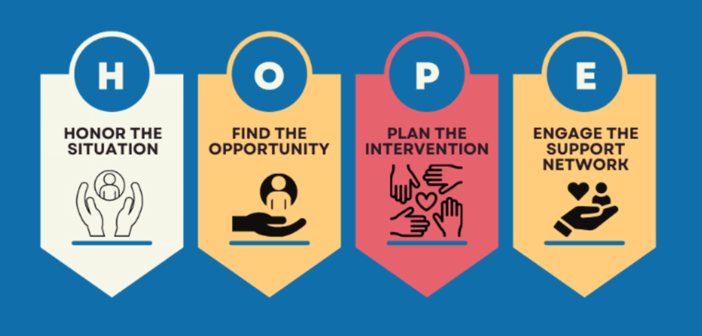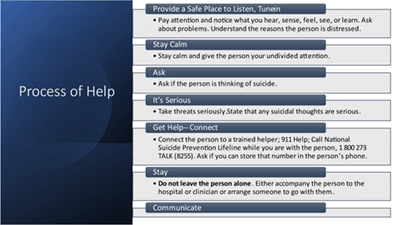Anne Mathews-Younes writes that faith leaders and faith communities are in a unique position to prevent suicide. She shares information about how to recognize the warning signs for suicide, ask the suicide question, and get help for those who are at risk.
More than 46,000 people died by suicide in 2020. It is the ninth most frequent cause of death in the U.S. and the second most common cause of death among teens and young adults. Moreover, it is a public health menace that spans the entire human lifespan, with men aged 75 or older having the highest rate of completed suicide. Statistically, of the 12.2 million people who seriously consider suicide, 10% act on these intentions in a way that could result in their deaths. (American Foundation for Suicide Prevention)
Given that these are staggering numbers, it is statistically inevitable that some of these people attend your church, live in your community, or are among your family and friends. For example, in a congregation of 200 people, eight members have had thoughts of suicide within the last year.
But there is hope. Because of strong social support, life-affirming values, and love, faith leaders and faith communities are in a unique position to prevent suicide. Faith communities are cultures of hope, bastions of faith, settings of hospitality, and places for life-engaging connection. Saving lives from suicide depends significantly on communicating hope and engaging people in meaningful connections. The Gospel of Jesus Christ is the Good News that brings much needed hope to those who are struggling with doubts, fears, or despair. Sharing the Good News of Jesus Christ is suicide care.
A Christian perspective on suicide prevention
A Christian perspective on suicide prevention begins with an affirmation of faith that nothing, including suicide, separates us from the love of God (Romans 8:38-39). Suicide is explicitly mentioned only six times in the Bible, and each biblical suicide has a context. Biblical accounts of suicide describe the inner struggles and emotional distress experienced by people who ended their lives — struggles of humiliation, pain, shame, and remorse, such as the suicide death of Judas Iscariot. The context of a suicide we see today may be different — emotional distress, relationship breakups, socioeconomic stressors, and more.
Faith leaders as first responders
More than half of persons who seek outside help when in crisis turn first to their clergy. However, most clergy have not received specific training in suicide prevention, and 49% of pastors say they rarely or never speak to their congregation about suicide, although 76% of churchgoers say suicide is a problem that must be addressed. When clergy respond to a suicide event in an unhelpful manner, it has been reported that up to 60% of previously engaged families leave the church in the aftermath of a suicide loss.
Is there more that you can do right now? Yes. One of the most helpful things church leaders can do is to educate their congregations about suicide and its prevention. It is also important to recognize the warning signs for suicide and know how to ask the suicide question and get persons help.
The warning signs
The National Institute of Mental Health (See Warning Signs of Suicide) outlines these nine warning signs in a person at risk of suicide:
- Expressing a wish to die or kill themselves
- Displaying withdrawal, isolation, depression
- Expressing hopelessness with no reason to live
- Talking of feeling trapped with no way out
- Experiencing unbearable pain and wanting relief
- Talking of being a burden to others “better off without me”
- Displaying anger and rage
- Posting about death, dying, or suicide on social media
- Demonstrating self-destructive behaviors
How to ask the suicide question and find help
It is fine to ask specific questions about how a person might be feeling and what they’re thinking. It could be something as simple as “It seems you have been struggling/worrying for a while now. Tell me. Are you thinking about killing yourself?”
Don’t worry. You will not plant the idea of suicide. If it’s there, it’s there. In fact, asking about suicide can make things better because you will convey that you can handle talking about it, so the person may feel less alone. The simple act of authentically listening and talking to someone during that vulnerable window of time between the thought of suicide and action can make an enormous difference.
- Then tell the person, “I am sorry you are feeling so badly. How can I help?” Say, “This is serious.” Let the person know that you are taking what they say very seriously and that it warrants immediate attention. Then: listen, listen, listen….
- Connect the person with help. If the person is having thoughts about suicide, persuade the person to get help — to call a help line (1-800-273-TALK (8255)), go to an emergency room, or call family members or a counselor. And if you are not sure what to do, you can text START to 741741 or call 1-800-273-TALK (8255) to chat with a trained counselor 24/7. Help is available by just reaching out and connecting.
Suicide is never inevitable. Helping someone find a safe environment that is full of the support, care, and treatment they need can and does save lives.
For more information about suicide prevention in faith communities, please contact The Way Consulting Int’l, a Division of the E. Stanley Jones Foundation.
Related Resources
- Starting a Conversation about Mental Health by Matthew S. Stanford
- The Church and the Response to the Mental Health Crisis, an in-depth interview with Matthew S. Stanford
- 5 Rules for Engaging Taboo Subjects in Churches by Elizabeth Evans Hagan





